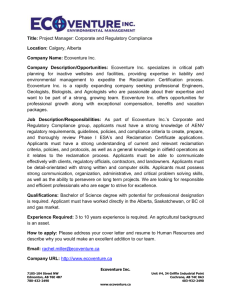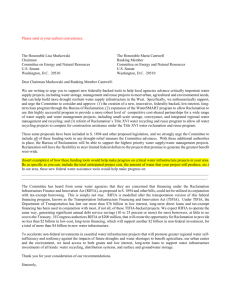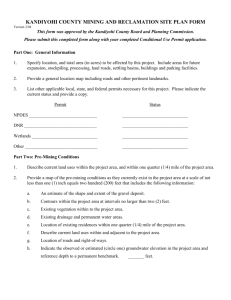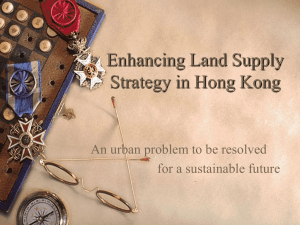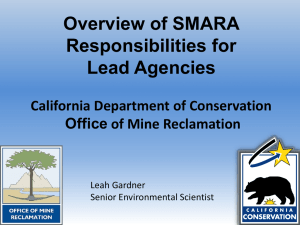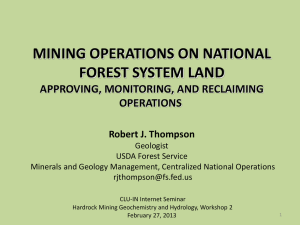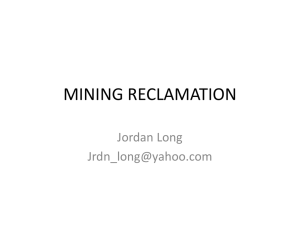Industrial Development and Reclamation
advertisement
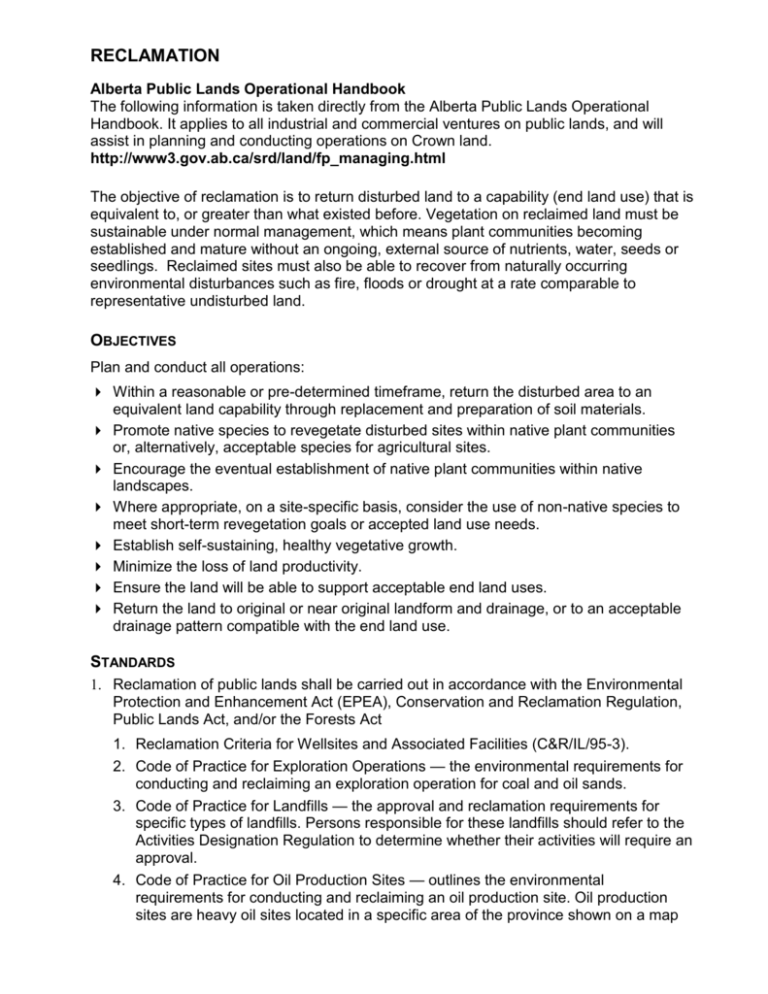
RECLAMATION Alberta Public Lands Operational Handbook The following information is taken directly from the Alberta Public Lands Operational Handbook. It applies to all industrial and commercial ventures on public lands, and will assist in planning and conducting operations on Crown land. http://www3.gov.ab.ca/srd/land/fp_managing.html The objective of reclamation is to return disturbed land to a capability (end land use) that is equivalent to, or greater than what existed before. Vegetation on reclaimed land must be sustainable under normal management, which means plant communities becoming established and mature without an ongoing, external source of nutrients, water, seeds or seedlings. Reclaimed sites must also be able to recover from naturally occurring environmental disturbances such as fire, floods or drought at a rate comparable to representative undisturbed land. OBJECTIVES Plan and conduct all operations: Within a reasonable or pre-determined timeframe, return the disturbed area to an equivalent land capability through replacement and preparation of soil materials. Promote native species to revegetate disturbed sites within native plant communities or, alternatively, acceptable species for agricultural sites. Encourage the eventual establishment of native plant communities within native landscapes. Where appropriate, on a site-specific basis, consider the use of non-native species to meet short-term revegetation goals or accepted land use needs. Establish self-sustaining, healthy vegetative growth. Minimize the loss of land productivity. Ensure the land will be able to support acceptable end land uses. Return the land to original or near original landform and drainage, or to an acceptable drainage pattern compatible with the end land use. STANDARDS 1. Reclamation of public lands shall be carried out in accordance with the Environmental Protection and Enhancement Act (EPEA), Conservation and Reclamation Regulation, Public Lands Act, and/or the Forests Act 1. Reclamation Criteria for Wellsites and Associated Facilities (C&R/IL/95-3). 2. Code of Practice for Exploration Operations — the environmental requirements for conducting and reclaiming an exploration operation for coal and oil sands. 3. Code of Practice for Landfills — the approval and reclamation requirements for specific types of landfills. Persons responsible for these landfills should refer to the Activities Designation Regulation to determine whether their activities will require an approval. 4. Code of Practice for Oil Production Sites — outlines the environmental requirements for conducting and reclaiming an oil production site. Oil production sites are heavy oil sites located in a specific area of the province shown on a map attached to the Code of Practice. Oil production sites that require an environmental impact assessment must have approval under EPEA. 5. Reclamation Criteria for Abandoned Railways (C&R/IL/96-3). 6. Reclamation Certification (RC) is required under EPEA for coal mines, oil sands mines, quarries, sand and gravel pits, borrow excavations, pipelines, wellsites, railways, roadways, peat operations, and transmission lines. To date, reclamation criteria have been developed for wellsites and abandoned railways. Reclamation of public lands shall be carried out in accordance with the dispositions and authorizations issued under the Public Lands Act, Forests Act, and Exploration Regulation. Reclamation (including silviculture and reforestation) within forested areas shall be conducted in accordance with the Alberta Timber Harvest Planning and Operating Ground Rules or Forest Management Agreement Timber Planning and Operating Ground Rules, and any additional conditions prescribed by the Minister. Regrowth and performance of desirable tree species on harvested or, as applicable, other denuded forested lands shall be in accordance with the Free-to-Grow Standards outlined in the Alberta Regeneration Survey Manual (May 2000). Weeds designated under the Weed Designation Regulation shall be controlled and/or destroyed in accordance with the Weed Control Regulation, or as designated by the local municipality. Reclamation that may impact a watercourse/waterbody, or results in the creation of a water diversion/waterbody, shall be in accordance with authorizations issued under the Water Act. Water quality and waste management should be in accordance with guidelines developed under EPEA. 10.1 PLANNING/PROCEDURAL GUIDELINE DOCUMENTS Conservation and reclamation of public lands should be carried out in accordance with the guidelines under the EPEA, Conservation and Reclamation Regulation, and other procedural documents. Guide for Oil Production Sites Guide for Pipelines Guide for Pits Guide for Transmission Lines Guide for Alternative Soil Handling Procedures During Pipeline Construction. A User Guide to Pit and Quarry Reclamation in Alberta. Land Capability Classification for Forest Ecosystems in the Oil Sands (C&R/IL/98-7 and report ESD/LM/98-1). Guidelines for Reclamation to Forest Vegetation in the Athabasca Oil Sands Region (C&R/IL/99-1 and report ESD/LM/99-1). Guideline for Wetland Establishment on Reclaimed Oil Sands Leases (C&R/IL/00-2 and report ESD/LM/00-1). All exploration, excavation and reclamation of surface materials (except peat) on public lands should be carried out in accordance with A Guide to Surface Material Resource Extraction on Public Lands. This document outlines the procedures for developing and reclaiming a surface material operation (except peat) on public lands. Native Plant Revegetation Guidelines for Alberta. Native Plant Working Group. (2001) — Outlines information on using native plants to re-establish a native plant community. The guidelines also include a listing of weeds from the Weed Control Act, how to interpret seed analysis certificates, commercially available native plant material, and guidelines on wild harvesting of native plants. (The guidelines are available from Public Lands and Forests Division.) Alberta Forest Seed and Vegetative Materials Policy and Guidelines Manual (June 2000). A Guide to Using Native Plants on Disturbed Lands. (1996) — Provides a starting point for planning revegetation projects and a listing of native trees, shrubs, forbs and grasses found on various site types in the different natural regions of Alberta. 10.2 Restoration SOIL Salvaged topsoil and surface strippings are needed to re-establish native plant species on disturbed areas. Viable native seeds and rootstocks contained in the surface soil material contribute to restoring a stable native plant community. Subsoils may need to be ripped or scarified before topsoil replacement to break up compaction. On non-forested sites, the topsoil or surface soils should be replaced evenly across the site. On forested sites, or where native vegetation and biodiversity are the goals, an uneven or variable topsoil depth may be preferred since it provides varying microsites. LANDSCAPE Landforms disturbed by industrial/commercial activities should be reclaimed/recontoured to resemble pre-disturbance conditions, blend into adjacent landforms, or meet intended end land use parameters. Re-contouring sites should be done using subsoil and spoil materials, not topsoil. The new landforms should be stable and designed to convey water to natural or constructed watercourses or waterbodies. 10.3 REVEGETATION The prime purpose of revegetation is to stabilize the soil by establishing a strong root system that minimizes erosion and helps to re-establish land capability/productivity. Revegetation is typically one of the last steps in the reclamation process; however, careful planning can greatly enhance the outcome. This is particularly true when native landscapes are involved. Native plant species, which may differ in various ecoregions, are generally preferred for reclamation, except in agricultural areas where the appropriate agronomic species may be used. The selection and application of a seed mix that has been recommended for a specific site depends on the following criteria: topography (e.g., slopes, hills); adjacent vegetation or vegetation in close proximity; aspect (orientation to sun exposure); water content and salinity of the soil; and type of soil. Although, grasses are generally used for reclamation, additional vegetation (e.g., forbs, shrubs, trees) may be required for specific sites. The best vegetation type/seed mix and fertilizer mixture can be determined using the following guidelines: Observe past successes on similar sites in the area. Obtain technical or professional advice from people who are experienced in the area, or who have had experience with similar sites (e.g., seed suppliers, agrologists, foresters, etc.). Obtain a soil analysis. On agricultural lands, it is generally useful to consult with the grazing disposition holder and/or the Land Manager to determine grazing patterns and how they can be managed to ensure successful revegetation. Fencing may be required to ensure the area is protected from damage by livestock. 10.3.1 Native Landscapes Where the site is surrounded by native plant species, the preferred method of revegetation is to re-establish native plant species in all areas, either by seeding or natural recovery (natural self-seeding). Revegetation of native landscapes is simpler, faster and less costly when the disturbance is minimized. The advantages of using native species are: maintains native ecosystem function and structure; provides a variety of ecological niches for other life forms; ensures landscapes are aesthetically pleasing, and that revegetation blends into the surrounding native landscapes; maintains genetic diversity; and often results in reduced long-term soil erosion owing to the superior soil-holding capability of the strong root matrix found in many native species; however, the native species may take longer to become established. RE-ESTABLISHMENT OF NATIVE PLANT SPECIES The conservation and use of local native plant materials is extremely important where rare or sensitive native plant species and communities are present, and also where important wildlife habitat must be conserved. Conserving the top few inches of soil that contain valuable seeds and rhizomes will enhance natural/native revegetation efforts. Cover crops can be used as a way to re-establish native plant species. NATURAL RECOVERY AREAS For small disturbances, the natural recovery option may be suitable if the erosion potential is low, problem weed invasion is low, and the surrounding natural landscape can provide a source of native plant material (usually seed). The main disadvantage of this option is the time frame, with 10 to 20 years required for successful revegetation to occur and the species composition, cover and density begin to resemble offsite conditions. Use the following criteria to assess disturbed sites on public lands with native landscapes: 2. Sufficient plant cover must be present to control erosion. Generally, a minimum of 50% live cover (absolute) and 10%–20% naturally produced litter is sufficient. More cover is required on slopes (75% live and 10%–20% naturally produced litter). 10.3.2 Seed The use of high-quality seed is important for ensuring successful revegetation. Knowing the seed purity, germination rate and where the seed comes from can prevent the introduction of undesirable weeds and invasive agronomic species. Prior to mixing, a certificate of seed analysis for each seed lot should be examined to determine if the particular lot is acceptable, and whether the germination levels are adequate to meet project goals. Seed lots should be free of prohibited, primary and secondary noxious and restricted weeds as defined by the Canada Seeds Act, the Weed Control Act and the local municipality. 10.3.3 Site Preparation Site preparation is one of the most important factors in determining the success of revegetation. Persistent weeds must be controlled before revegetation, which may take several years of active control. If forbs, trees or shrubs are planted on a site, or recolonization by these plants is desired, care must be taken to use weed control methods that will not harm these plants. Site preparation using equipment that produces ridges and hollows creates microsites, which can enhance plant survival. This is particularly useful in environments that are susceptible to drought or wind. 10.3.4 Forested Lands/Timber Production Reclamation for major disturbances on forested land may require annual, periodic, and long-range operating and reclamation plans to be submitted for approval. Reclamation of disturbed forested lands should include recontouring to an acceptable landform, and revegetation to achieve soil stabilization for the desired end land use (e.g., timber production, agricultural purposes, aquatic and terrestrial habitat, and various kinds of recreational activities). Native species are highly recommended in forested areas to minimize problems associated with competing species. The relative value of a reclaimed site for commercial forestry is determined by: landscape design and placements of polygons; soil productivity; and size, shape and species of each vegetation community polygon. 10.3.5 Wildlife The relative value of a reclaimed site for wildlife habitat is determined by the following: its contribution to the overall food, cover, and space requirements of indigenous wildlife species; the degree to which diverse and productive, pre-disturbance natural vegetation communities and habitat types are re-established, including wetlands and open waterbodies; and the degree to which pre-disturbance and special habitat features are re-established, such as natural mineral licks, cliffs and caves. 10.3.6 Temporary Erosion Control In some cases, temporary erosion control may be used to stabilize the soil on the disturbed site until the seeded native species can become established, thus increasing the potential of revegetation success. CRIMPING Crimping is a soil stabilization technique that presses straw (or native hay) into the soil in a wave-like pattern. It has been used extensively in southern Alberta on wellsites and pipelines to prevent soil erosion. Straw is spread over the site and a straw crimper with a rolling drum is used to press one end of the straw into the soil, pushing the other end upright. Crimping can provide protection for emerging seedlings, trap snow and help water infiltrate the soil. COVER CROPS Cover crops are generally used only where there is a concern about the potential for erosion on the reclaimed area. Any crop that is used should be non-persistent and noninvasive. If cover crops are used as a method to re-establish native plant species, the decision should be based on the site type, available moisture, potential competition for native seedlings, and the type of animals that may graze on the site. When cover crops are used, they should be seeded at half the normal rate (e.g., 1/2 bushel per acre). Annuals should be seeded separately from the native mix, with annuals seeded in the spring and the native mix in the fall. The cover crop can be mowed if it seems to be competing for moisture and light with establishing native plants. 10.4 ROAD ABANDONMENT Road abandonment is directly related to the purpose of the road and the type of use the road will receive. The potential need for road abandonment should be considered in advance, preferably during the planning stages. 10.4.1 Temporary Abandonment Temporary abandonment of a graded road requires complete removal of all drainage and crossing structures. Cross-drains, diversion ditches and other erosion control measures should be installed as necessary. Although the grade will remain, all exposed surfaces should be revegetated. Entry onto the road should be blocked and an active maintenance program implemented. 10.4.2 Permanent Abandonment Permanent abandonment of both graded and non-graded roads requires all drainage and crossing structures on the road rights-of-way to be removed completely. The rights-of-way must be reclaimed in a manner that ensures landforms are compatible with the surrounding landscape, vegetation cover is established to stabilize the soil, and productivity of the land is comparable to the adjacent undisturbed area. Sensitive areas may require varying stages and degrees of reclamation. Scarification of road surfaces, recontouring of rights-of-way, replacement of soil material and surface strippings, and seeding with an acceptable plant species are all required as part of permanent abandonment. Depending on the site, debris may be scattered on the rights-of-way and walked down (compacted) for erosion control and revegetation purposes. Roadblocks on all access points leading to the rights-of-way may be necessary to discourage vehicle traffic, and to allow stabilization and re-vegetation of the abandoned area. Under EPEA, reclamation certificates are required for roads associated with wellsites, pipelines, transmission lines, pits, borrow excavations and other forms of “specified land”. 10.4.3 Watercourse Crossings (roads) When planning a crossing structure, methods for effective abandonment should be considered. Each crossing site should also be assessed and reviewed to determine the potential for successful rehabilitation of riparian vegetation and fish habitat after abandonment. Work in a watercourse/waterbody may require a disposition/authorization under the Public Lands Act, Water Act and/or federal Fisheries Act. Abandonment of watercourse crossings may include: complete removal of all culverts; complete or partial removal of all bridges; complete removal of abutments in specific situations (abutments may be retained where they provide erosion protection and habitat for fish); installing cross drains and diversion ditches on all approaches; restoring and stabilizing streambanks, including the use of logs or gabions; creation of overhanging banks; revegetating all disturbed areas after landforming and recontouring; planting trees and shrubs in addition to normal seeding; and taking measures to prevent vehicular access after abandonment. Follow-up inspections should be done to assess the effectiveness of rehabilitation measures on the crossing site. Additional measures for erosion control and streambank protection may be needed. Industrial Development and Reclamation A number of industrial activities are carried out on public land within Alberta. This includes Mineral Surface Leases [MSL], Licences of Occupation [LOC], Pipeline Agreements [PLA], Pipeline Installation Leases [PIL], Easements [EZE], Vegetation Control Easements [VCE], and Rural Electrification Association Easements [REA]. Reclamation of industrial and commercial holdings is required for all public land. Many activities, including upstream oil and gas, sand and gravel, oil sands, and coal operations, are defined as 'specified land' under the Alberta Environmental Protection and Enhancement Act (AEPEA). Reclamation clearance for these types of activities requires a reclamation certificate to be issued once the site is reclaimed. For information regarding reclamation of 'specified land', including the reclamation criteria and application forms currently in use, the following website should be visited: http://www3.gov.ab.ca/env/protenf/landrec/publications.html. Definition from the Conservation and Reclamation Regulation Specified Land means land that is being or has been used or held for or in connection with: the construction, operation or reclamation of a well, oil production site, or battery; the construction, operation or reclamation of a pipeline, telecommunication system or transmission line; the construction, operation, or reclamation of a mine, pit, borrow excavation, quarry, or peat operation; the construction or reclamation of a roadway; the conduct or reclamation of an exploration operation for coal or oil sands; the reclamation of a railway; and The application form for borrow operations, pits, quarries, and peat is still under review, so for the present time, clients can use the Request for Reclamation Certificate. Other types of industrial and commercial activities have reclamation requirements that are not governed by AEPEA and therefore use of this land is termed 'non-specified'. Reclamation clearance is under the jurisdiction of other Acts, primarily the Public Lands Act, and these activities require a Letter of Clearance to be issued once the site is reclaimed. Letter of Clearance (Geophysical Site Condition Report) Letter of Clearance (timber roads) Letter of Closure(no entry) The previous form can be used for asking for a holding to be cancelled by simply ticking off the second box stating that no entry has occurred at this site. No plan is required. Alternatively, you can submit a short request on your company letterhead stating no entry and requesting that the holding be cancelled. All requests for reclamation closure on Public Land, whether by Letter of Clearance or Reclamation Certificate should be directed to the Public Lands and Forests Division, Alberta Sustainable Resource Development. Requests may also be forwarded via e-mail to: Reclaim.Account@gov.ab.ca (electronic applications).
